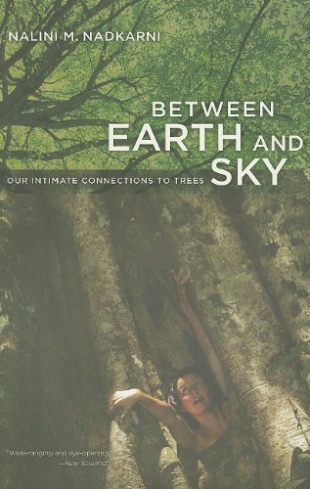"I love trees: how they look, how they behave, how they smell and sound, and how I feel when I am around them. When I place my own strong brown hand on the trunk of a tree, I feel connected to something that deserves my curiosity, care, and protection," writes Nalini Nadkarni, who teaches in the Environmental Studies Program at The Evergreen State College and is President of the International Canopy Network. She has climbed, studied, and talked to trees on four continents. In this capacious and enlightening book, Nadkarni covers the breadth and depth of our relationship with trees, our dependence on them, and the wisdom teachings they offer to us. One of the many grace notes in Between Earth and Sky is the wonderful treasure trove of poems about trees that the author has gathered.
The structure of the book is based on a modification of Abraham Maslow's hierarchy of needs as fulfilled by trees. On a physical level, trees provide us with air, food, and water. Other material necessities include a dazzling array of goods and services such as brown bags, cartons, corks, paper, books, bulletin boards, buttons, toothpicks, personal checks, and much more. According to the Food and Agriculture Administration report published in 2007, each year Americans use more than 90 million tons of paper and paperboard, or 950 pounds of paper products per person — one-third of the world's paper.
Trees provide us with security in terms of shelters, windbreaks, and a sense of place. They are essential to the construction of our homes and offices. In the winter, wood from fires keeps us cozy with warmth and light. In our neighborhoods and communities, trees are landmarks that give us a sense of rootedness and an appreciation of place. Trees help keep us healthy and balanced; they provide the ingredients for healing used by indigenous peoples around the world along with Western practitioners of medicine. Equally important is the role they in play in giving us pleasure by stirring our imaginations.
Moving up Maslow's hierarchy, the author writes about the many ways in which trees enable us to cultivate a sense of history and to put our actions in an evolutionary context. They also relate to language and symbols: think of the challenge of "not barking up the wrong tree" or using trees to bolster items of value.
Trees have played a large role in the spiritual life of many cultures and religions. Here Nadkarni alludes to the Tree of Life and the Tree of Knowledge of Good and Evil in the first book of the Bible, the sacred groves, or the enlightenment of the Buddha under the spreading limbs of the Bodhi tree. In the last chapter, the author makes a plea for mindfulness about trees in a time when more and more people (especially youth) are cut off from contact with forests and other aspects of the natural world.
Here is a sampler of some of the wonderful things to be found in this book:
"Let me stop to say a blessing for these woods . . .
for the way sunlight laces with shadows
through each branch and leaf of tree,
for these paths that take me in,
for these paths that lead me out."
— Michael S. Glaser, "A Blessing for the Woods"
"We have nothing to fear and a great deal to learn from trees,
that vigorous and pacific tribe which without stint produces
strengthening essences for us, soothing balms, and in whose
gracious company we spend so many cool, silent, and intimate
hours."
— Marcel Proust, Pleasures and Regrets
"When we are stricken and cannot bear our lives any longer, then a
tree has something to say to us: Be still! Be Still! Look at me! Life is not easy, life is not difficult."
— Hermann Hesse, "On Trees"
"Soak up the sun
Affirm life's magic
Be graceful in the wind
Stand tall after a storm
Feel refreshed after it rains
Grow strong without notice
Be prepared for each season
Provide shelter to strangers
Hang tough through a cold spell
Emerge renewed at the first sign of spring
Stay deeply rooted while reaching for the sky
Be still long enough to hear your own leaves rustling."
— Karen Shragg, "Think Like a Tree"
